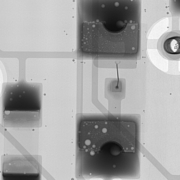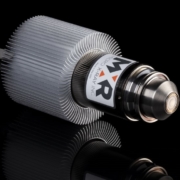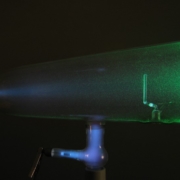Operational Tips: X-ray Coverage and Magnification Formulas and Calculator
X-ray Coverage and Magnification Formulas
Important Angles and Distances in X-ray Imaging
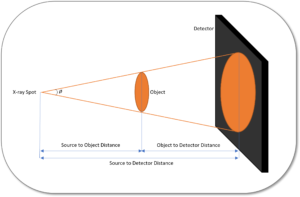
Geometry of a typical X-ray application showing the X-ray source, the Object being imaged, and the X-ray detector.
X-ray Coverage Formulas

Calculation of the radius of the X-ray radiation coverage of an object
The coverage area on the detector may be calculated with the same formula, but swapping out the distance variables for Source to Detector distance:

Calculation of the radius of the X-ray radiation coverage of an X-ray detector
Geometric Magnification Formula
Geometric magnification is an easy concept with a (unnecessarily?) confusing name. This is simply the magnification of the object being imaged on the surface of the detector. For example, if you are measuring a 50μm feature, an 8x geometric magnification factor will blow that feature up to 400μm on the detector surface. Understanding your magnification and the size of the features you need to resolve will help you select the correct detector for your application.
Try this: hold your cell phone flashlight a fixed distance away from a flat table, the put a single finger half way between the camera LED and the table. The shadow of your finger on the table will be about 2x its real size. If you hold your phone in one spot and move your finger up and down, you can see the magnification change. As you move your finger closer to the table, the shadow shrinks; as you move your finger closer to your phone, the shadow grows. You can also change the magnification by holding your finger a constant distance from your phone, and moving the phone/finger pair closer and further from the table.
Geometric magnification of X-rays works identically to its counterpart in visible light and shadows. The magnification factor is just a simple ratio comparing the Source to Detector distance to the Source to Object distance:

Calculation of the Geometric Magnification ratio
X-ray Coverage Calculator
Try it yourself! Use the calculator below to check your coverage dimensions and magnification factor for your application or use case.
Practical Limits
It’s important to understand that your can’t increase your magnification infinitely, as there are some real-world constraints to contend with. We’ll cover these more in future articles, but for now keep in mind the following:
- X-ray radiation intensity falls off with distance squared. This means the further away your source is from your detector, the fewer X-rays make it to the detector. At some point, the detector is just too far away to record any meaningful amount of X-ray flux.
- The opposite is also true! If your detector is too close to the source, there may be so much flux that the detector floods and can’t produce a reliable image.
- The resolution of an image is not only controlled by the magnification, but also the X-ray source. As a rule of thumb (and of course there are exceptions – there are always exceptions), the smallest image you’ll be able to resolve is around the same size as your X-ray spot. No matter how much you magnify an image, you’ll never resolve a 10μm feature with a 100μm spot size X-ray tube.
Let’s Talk!
Contact us today to talk about your imaging application, our Microbox source which is purpose-built for X-ray imaging, or anything else X-ray related!
